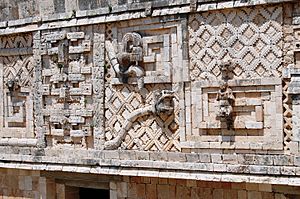Can Pech facts for kids
Quick facts for kids
Kuchkabal Kaan Peech
|
|||||||||
|---|---|---|---|---|---|---|---|---|---|
| 1441–1540 | |||||||||

Kuchkabals of Yucatan after 1461; Can Pech is center left.
|
|||||||||
| Capital | Campeche, Campeche | ||||||||
| Common languages | Official language: Yucatec |
||||||||
| Religion | Maya religion | ||||||||
| Government | Monarchy | ||||||||
| Halach Uinik | |||||||||
| Historical era | post classic period / Early Modern | ||||||||
|
• Established
|
1441 | ||||||||
|
• Disestablished
|
1540 | ||||||||
|
|||||||||
Can Pech (also known as Kaan Pech) was a powerful Maya kingdom. It was located on the southwestern part of the Yucatán Peninsula. This was before the Spanish explorers arrived in the 1500s.
Can Pech was situated along the coast of the Gulf of Mexico. It was south of another kingdom called Ah Canul. To its north was Chakán Putum. In 1517, the main city of Can Pech, which was called Campeche, had about 36,000 people.
Contents
What Does "Can Pech" Mean?
In the Yucatec Maya language, Kaan Peech means "snake tick". The kingdom of Can Pech was started by a leader named Ah k'iin Peech. The title Ah K'iin meant he was a high-ranking priest.
History of Can Pech
Before Can Pech Existed
Long before Can Pech became a kingdom, many important Maya cities grew in this area. These included places like Becan, Edzná, and Calakmul. Most of these cities were part of a larger group called the Puuc polity.
Around the early 900s, a group called the Toltecs took control of northern Yucatán. After the Toltecs left, the League of Mayapan became the main power. This happened in 987.
How Can Pech Was Founded
In 1441, a big civil war broke out. It was between two powerful Maya families, the Cocom and the Tutul-Xiu. This war was so intense that by 1461, the League of Mayapan completely fell apart. It broke into many smaller independent kingdoms, which the Maya called Kuchkabal.
It was during this time of change that Ah k'iin Peech established the kingdom of Can Pech.
First European Contact
On March 22, 1517, a Spanish ship arrived at Campeche city. The Spanish explorers traded with the Maya people for water.
One of the Spanish explorers, Bernal Díaz del Castillo, wrote about their visit. He said they found a good well where the Maya drank water. The Spanish filled their water barrels there. About 50 Maya people, including some leaders, came to meet them. They seemed peaceful and asked the Spanish where they came from. The Maya kept saying "Castilan," meaning "Castilian," which was a Spanish word.
The Spanish were then invited into the city. They were shown palaces and pyramids. At first, everyone got along well. However, things became tense. The Maya priests, called "potatoes" by the Spanish, arrived. They had long cotton clothes and hair matted with blood. They burned incense and warned the Spanish to leave their land before the incense fire went out. If they didn't leave, the Maya would fight them.
The Spanish Conquest
In 1526, Francisco de Montejo received permission from Spain to conquer the Yucatán. He began his invasion in 1527.
Francisco de Montejo started in the east and moved west. By 1529, his forces were so weak that they had to go back to Spain, defeated.
In 1531, the Spanish tried again. This time, they went directly to the city of Campeche. They managed to conquer Can Pech after a battle. However, the Spanish had very few soldiers left. Then, about 20,000 Maya soldiers arrived, and the Spanish were easily defeated and forced to retreat again.
The third and final invasion began in 1540 in Chakan Putum. The Spanish sent messengers to Can Pech. They wanted the local leaders, called "Batab," to promise loyalty to the Spanish crown. On October 4, the Spanish invaded Campeche. The city was overwhelmed, partly because some Batab leaders had betrayed their people by agreeing with the Spanish.
How Can Pech Was Organized
After the war between the Tutul Xiu and Cocom families, the Yucatán Peninsula split into 16 independent kingdoms, or Kuchkabal. In the area that is now the state of Campeche, there were three main kingdoms: Ah Canul, Can Pech, and Chakán Putum. These kingdoms often had conflicts with each other.
Each Kuchkabal usually had a capital city. This is where the main ruler and supreme priest lived. The ruler was called a Halach Uinik. Each kingdom was divided into smaller areas called "Batabil." These areas were led by officials called "Batab." The Batab were often related to the Halach Uinik. Each Batab was also the military leader for his people.
In terms of religion, after the Halach Uinik, there was a high priest called the Ah Kin May. Below him were the regular priests, known as Ah Kin (meaning "coming from the Sun"). There was also a special priest called "Ah Nacom" who performed sacrifices.
Geography and Population
Most of the people in Can Pech lived near the coast. The Puuc hills, which had many people during the Classic Maya period, were mostly empty after the Maya collapse.
When the Spanish first arrived, there might have been as many as 36,000 people in Campeche city. However, by 1540, only about 5,985 people were left. This big drop in population was mainly due to diseases like smallpox, which the Europeans brought with them.
See also
 In Spanish: Can Pech para niños
In Spanish: Can Pech para niños
- Maya civilization
- Campeche, Campeche, the modern city built on top of ancient Can Pech
- Kuchkabal





